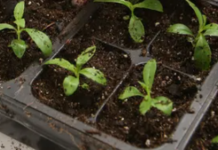As outdoor plants break dormancy and start to grow in response to the longer days and warmer spring temperatures, houseplants usually put on a spurt of growth as well. Eventually, these indoor plants out-grow their containers and need to be repotted.
To check if your plants are becoming root bound and need a larger pot, inspect the root system.
First, knock the plant out of its pot. Watering several hours before this operation will allow the plant to be removed more easily. On pots that are 8 inches in diameter or less, place one hand over the top of the pot with the stem of the plant passing between two fingers, and turn the plant upside down. Then rap the edge of the pot against a table. The root ball should come away from the pot. On pots that are more than 8 inches in diameter, a bit more encouragement may be needed.
Place the pot on its side and rap the top edge of the pot with a rubber mallet. Turn the plant a few degrees, and repeat the procedure until the root ball releases.
Once the plant is free, take a look at the root ball. If you see a clear network of roots, the plant needs to be moved to a larger pot. If the original pot is less than 10 inches, move up an inch in size; if 10 inches or larger, increase the size 2 inches. If the pot has one or several large holes in the bottom for drainage, cover the holes with pot shards (pieces of a broken clay pot) or gravel so that the potting mix is not washed out during watering.
It is essential that the plant sit at the same level it was in the old pot. Add enough potting mix to the bottom of the pot to ensure this.
This mix will need to be firmed before the plant is placed on top of it so it doesn’t settle over time. After the plant is placed, fill in around the original root ball with potting soil. Again, firm this soil with a slender stick, or tap the bottom of the pot on the table. If this firming is not done, new soil will be so light and airy that water will tend to move through it rather than through the entire root ball.
Water the plant thoroughly after repotting, but be especially careful not to overwater for about two weeks. The new soil tends to stay wet until roots penetrate. Overwatering can lead to rot.
Most plants need to be repotted annually though vigorous growers may need to move up sooner. Slow-growing plants may stay in the same pot for more than a year. (Ward Upham)
Plants Breaking Dormancy Early
Plants that become dormant in preparation for winter must have a certain number of “chilling hours” before the buds will begin growth the next spring. “Chilling” hours are those in which the temperature remains between 32 and 45 degrees F.
Plants differ in the number of chilling hours needed, with those adapted to colder climates usually requiring more than those adapted to warmer zones. Even plants within the same species can differ markedly in the number of chilling hours required for bud break. For example, apple varieties range from a low of 250 (or fewer) chilling hours to a high of 1700.
The chilling requirements of some plants have been met already this winter. For these plants, dormancy is over and warm periods can lead to bud swell or even flowering. If spring-flowering bulbs flower now, the floral parts may be damaged by a cold snap but the plants itself will likely be OK. It all depends on the severity of the cold snap.
So what do you do if you have a plant that has swollen buds?
Actually, there is not much you can do to slow the bud development process because it is completely dependent on weather. However, watering during dry weather may help in an indirect way. Roots can suffer drought damage during the winter. A tree with a damaged root system and damaged buds will be slower to recover than one with just damaged buds. Readily available soil moisture will aid in keeping the plant healthy so it will be better able to recover from cold damage.
Also, it is important to determine if the swollen buds are flower buds or leaf buds. Even if the flower buds are killed by cold temperatures, the health of the plant should not be affected. If, in addition to the swollen buds, you also see small buds on the stems, then the swollen buds are flower buds and the small buds are leaf buds.
Leaf buds are more hardy than flower buds but even they can be killed if they have lost their winter hardiness. Even if the leaf buds swell and are killed by a cold snap, a healthy tree will still be able to survive. There are secondary buds that remain dormant unless the primary bud is killed. Secondary bud growth may be slower and less vigorous, but the tree will eventually recover. (Ward Upham)



